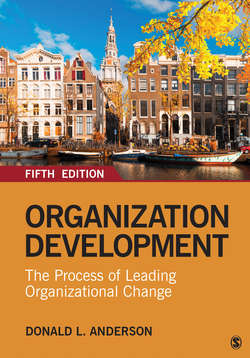Читать книгу Organization Development - Donald L. Anderson - Страница 40
На сайте Литреса книга снята с продажи.
Organizational Culture
ОглавлениеA 1980 BusinessWeek article brought the concept of corporate culture into the popular vocabulary of managers and executives searching for a competitive advantage. It reviewed such well-known companies as AT&T, IBM, and PepsiCo, highlighting the corporate values that drove their success and promoting the idea that a company’s strategy and culture must be in alignment for the organization to succeed, directly linking corporate results with organizational culture. The article concluded that if strategy and culture were not in alignment, either the strategy or the corporate culture must change (“Corporate Culture,” 1980).
The concept of a “culture” predominantly originates from the field of anthropology and conjures images of social scientists observing distant countries and social groups. Similarly, OD practitioners and those who study corporate or organizational cultures have been called “organizational anthropologists” (Smircich, 1985, p. 65), whose task it is to decipher not only “how things are done around here” (a common definition of culture) but also the hidden meanings and assumptions that characterize how organizational members interpret and make sense of what is happening, or “how people think around here.”
Culture has been defined in various ways, but most agree that a shorthand definition of culture is “the shared attitudes, values, beliefs, and customs of members of a social unit or organization” (Walter, 1985, p. 301). Schein (2004) provides a more detailed definition:
A pattern of shared basic assumptions that was learned by a group as it solved its problems of external adaptation and internal integration, that has worked well enough to be considered valued and, therefore, to be taught to new members as the correct way to perceive, think, and feel in relation to those problems. (p. 17)
Culture consists of symbols and the shared rules and norms that comprise a collective mind-set within the organization. For example, an announcement that a senior vice president is leaving the company ostensibly to “pursue other opportunities” could be interpreted by organizational members as a sign that the company’s future is questionable or that the division led by the senior vice president is not meeting its goals, or it could instill confidence that senior leaders are held accountable, bolstering morale in the division. What may appear to be a bizarre interpretation from an outsider’s point of view often makes perfect sense to those well versed in the cultural norms and interpretive patterns that have been adopted by someone inside the organization. These cultural patterns become easier to identify and read the longer the time spent in the organization. Cultures perpetuate themselves through socialization, particularly when new members to the culture are reprimanded for violating cultural norms or rewarded for assimilation (Schein, 2004).
Two popular books from 1982 called attention to the concept of culture and its importance to managers and executives. Peters and Waterman’s (1982) book In Search of Excellence documented the cultural values of the most successful business firms of the time, such as a bias for action and being close to the customer. They argued, as did Deal and Kennedy (1982) in Corporate Cultures, that organizations can improve productivity and profits by changing the culture, accomplished by changing cultural values. Some organizational values, such as believing that the organization is impervious to competitive threats, jeopardize certain adaptive behaviors (such as environmental scanning and a drive toward transformative change). Values changes can be accomplished by reinforcing new patterns, telling new stories, using different language and communication patterns, and adopting a different decision-making style.
The commonsense culture perspective as a lens on organizational life began to dominate practitioner and academic literature as managers and consultants became interested in strategies to intervene in and change organizational culture. Managers began to search for the magical elements of the “right” culture that would be the key to success, while some writers debated whether intentional culture change was possible (Martin, 1985) or ethical (Deetz, 1985). Among academic audiences, the culture perspective, as it came to be known, spread quickly because it resonated with those researchers dissatisfied with quantitative and experimental methods and who were interested in alternative ways of understanding organizations (Eisenberg & Riley, 2001; Ott, 1989). Some critiqued the organizational culture concept, arguing that conceiving of an organization as a single, monolithic culture ignores organizational subcultures that have their own shared meanings, one possible explanation for within-organization conflicts.
Organizational cultures also exist within local or national cultures that have their own influences on the behaviors of organizational members. Consequently, “culture” as an explanation for behavior or as a target for change can be limiting. For example, is an engineering manager in Singapore who works late into the evening doing so because that is how things are done in Singapore, because that is how things are done at this particular company, because that is how engineers work, or for some other reason? Culture may be a useful concept as a lens on what is happening, but it is clear that it is not the only explanation.
Nevertheless, to the OD consultant, symbolic and cultural observations about an organization remain a powerful source of data (we will consider the role of culture in data gathering in Chapter 7). Honing one’s skill in observing and understanding organizational culture allows the OD consultant to better understand potential obstacles and areas of resistance to any change. It focuses the practitioner on underlying assumptions and implicit meanings that organizational members cannot always articulate explicitly. We will discuss the concept of culture change in organizations in more detail in Chapters 12 and 13, especially as culture has become a relevant concept in mergers and acquisitions.
